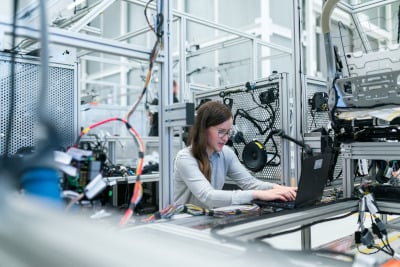 A woman working on the line and thinking about the top manufacturing trends to watch in 2021.
A woman working on the line and thinking about the top manufacturing trends to watch in 2021.
Let's face it — the 2020s didn't start as well as we all hoped they would, and the COVID-19 pandemic brought us many new challenges. We had to deal with supply chain instability, transportation issues, lack of workers, and inflation. However, all those troubles forced companies to catch up. Digital transformation became the new buzzword, and it seems that with these new technologies in our hands, there are endless opportunities for growth and improvement. To get you a bit closer to them, today we're talking about the top manufacturing trends to watch in 2022.
Consumer-Driven Manufacturing
Sometimes, it seems that technology can't evolve as quickly as consumer demands shift. Of course, this makes it hard for manufacturers to provide the products and services people are after fast enough.
At the very least, customers want same-day delivery, personalized products, and shipment tracking. However, you have to work hard to keep up with this kind of service and stay competitive in the global market. Your system's agility and flexibility must be at their finest, and not many companies can afford to become that optimized.
Instead, the goal is to focus on anticipating your customers' needs and stay ahead of the curve. But, of course, no human can do this, so we must resort to new technologies. And here, we're primarily talking about:
- Data analytics
- The Internet of Things (IoT)
- Artificial Intelligence (AI)
Of course, when you get this far, you can't stop here, and you should also up your game when it comes to quality control, as this is an essential link in the process. Not only will your products get to your customers faster, but you'll also make them better quality.
.jpg?width=400&name=Top%20Manufacturing%20Trends%20to%20Watch%20in%202022%20(1).jpg) The goal of consumer-driven manufacturing is to stay ahead of the curve and predict the demand before it happens.
The goal of consumer-driven manufacturing is to stay ahead of the curve and predict the demand before it happens.
Predictable Supply Chains
At the moment, the supply and demand situation on the market isn't stable, to say the least. Dynamics are all over the place, and manufacturers from all over the world are dealing with complications. We hear complaints about consumer demand, rising costs of materials and transport, and slow deliveries all the time. So what can we do about it?
Well, we should search for a way to make our supply chains more predictable. The answer could lie in letting AI and sensors help us notice patterns in the processes and predict future demand. As a result, you get a chance to keep your inventory much neater, and it will show in your revenue.
Still, if you're a bit late with the predictions and you need to catch up to your competitors, transporting your goods via air might be the way to go. Of course, air shipping is more expensive than ocean freight, but your customers will get what they need sooner, and if you can consolidate shipments, you'll even save some money along the way.
Connected Services
Connected services are undoubtedly one of the top manufacturing trends to watch in 2022. The technology is changing business operations, adding a twist on what manufacturers can offer their customers.
In essence, these are additional things you can offer your customers for any of your products that use the internet. For example, healthcare devices, vehicles, heavy machinery, and even hand tools all connect to the web these days. So, if you can add some new benefits to the mix and make the product more usable through it, people will be glad to pay for it.
Offering connected services will make you stand out in the crowd and give you an edge over the competition. On top of that, you'll have the added benefit of gathering data at every point of the customer journey. You'll get some insights into how they think, and you'll be able to improve the quality of the product you supply them with.
It's also worth mentioning that connected services come with higher margins, creating regular revenue streams. You'll have to invest some money into development, but it will pay off long-term.
.jpg?width=400&name=Top%20Manufacturing%20Trends%20to%20Watch%20in%202022%20(2).jpg)
Controlling a car via phone is one of the most popular connected services at the moment.
Smart Factories
Right now, only the big players can afford intelligent factories. However, we'll see more and more small manufacturers implementing features that existing smart factories are helping to develop. They'll use more sensors to track products on the line as well as the inventory, and they'll love cloud-enabled machines as they'll notify them when they're up for maintenance.
Don't get us wrong — you'll still need third-party inspections from time to time, but your production will run much smoother, and you'll have fewer issues with your end product. Moreover, robots will help you adjust and meet customer demands in no time.
Industry 4.0 and the Digital Economy
We have the privilege to live during the fourth industrial revolution, or industry 4.0 as people like to call it. The last revolution brought us digital technologies, but this one is taking everything a step higher. Of course, we're talking about hyper-automation, IoT, smart factories, and big data, all of which brought us a new economy based on digital technologies — the digital economy.
Today, it's all about bridging the physical and cyber worlds. Just look at companies like Netflix, Uber, and Airbnb. They wouldn't exist without the internet, and yet everybody uses them. They're prime examples of the digital economy, and your business can become one too.
Let your devices connect to the internet, and you'll get insights that no one even dreamed about just a few years back. These will allow you to help your customers more, and they'll stick with you thanks to that.
.jpg?width=400&name=Top%20Manufacturing%20Trends%20to%20Watch%20in%202022%20(3).jpg)
Cryptocurrencies are one of the products of the digital economy.
Sustainability
In the last couple of years, people have become much more aware of how fast we're depleting Earth's resources. Of course, the shifting demands aren't helping here, but people want to know you're putting as little pressure on the environment as possible.
Unfortunately, we're still far away from using self-healing materials every day, but there are still ways to cut your company's carbon footprint down.
The circular economy is gaining popularity, and more and more manufacturers are turning to it. It uses the power of AI and machine learning to help you streamline your operations, streamline your processes, and increase efficiency. Thanks to it, your company can reduce waste and cut costs, and for that, it's one of the top manufacturing trends to watch in 2022.







